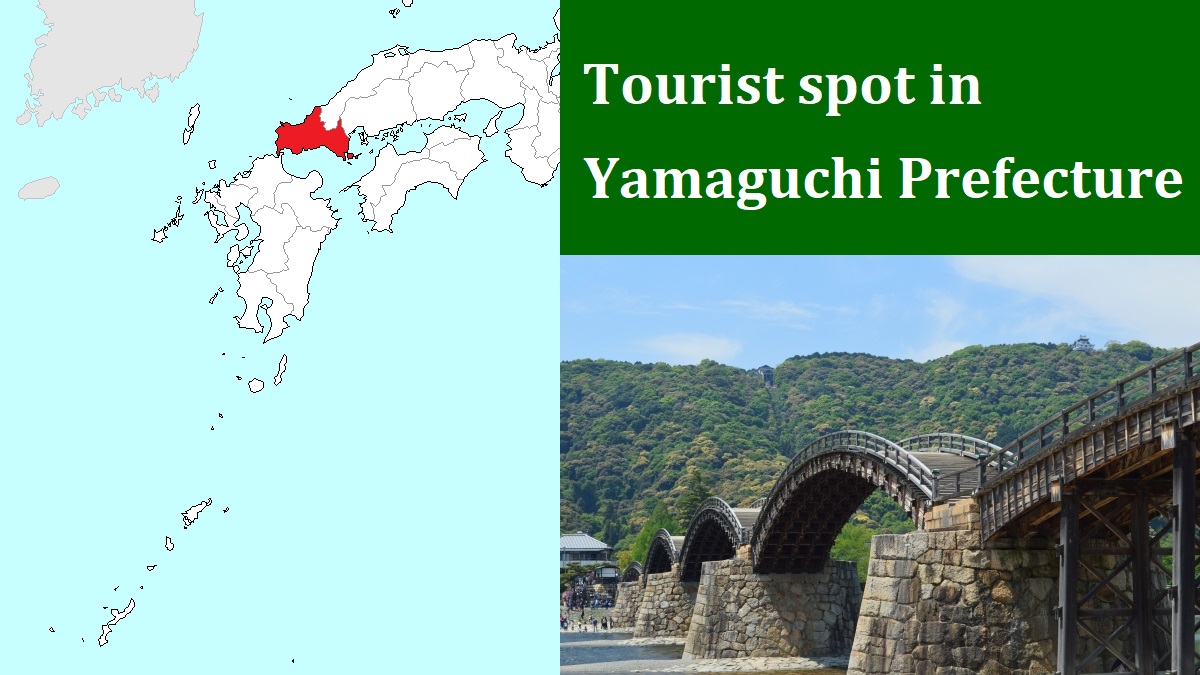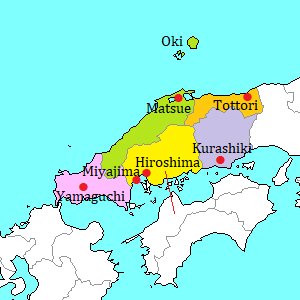Hagi city [萩]
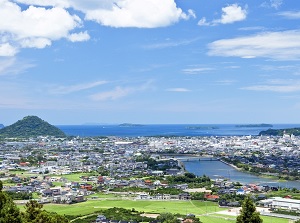
Hagi city
Photo: Yamaguchi Prefectural Tourism Federation
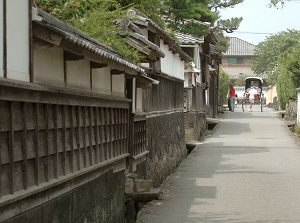
Edoya-Yokocho in Hagi
Photo: Yamaguchi Prefectural Tourism Federation
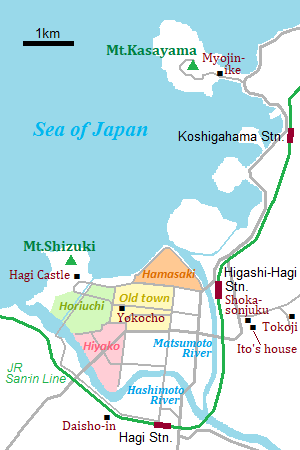
Hagi is a small city facing the Sea of Japan, and is in the north part of Yamaguchi Prefecture.
It is located about 35 km north of Yamaguchi city.
A castle was built in 1608, then the castle town developed.
Since that, this city had been the center of politics in Chôshû Clan (長州, Current Yamaguchi Prefecture) over a period of about 260 years.
In the castle town, many old buildings still remain.
From the early 17th century, Japan had taken an isolation policy.
In the middle of the 19th century, western powerful countries started coming to Japan to ask the government to open the country.
But the government rejected their requests and persisted to a policy of isolation.
Choshu Clan was revolutionary, so it became one of the forefront to overthrow such feudal government.
Yoshida Shoin (1830-1859) who was a samurai with radical thought opened a school in Hagi, and produced many samurai to create a new modern nation.
Then, the Clan office was moved from Hagi to Yamaguchi city in 1864, then Yamaguchi became the central base to overthrow the government.
In 1868, old Edo Government was overthrown and new Meiji Government was founded.
Several learners of Shoin's school became the leaders of new government.
The central area of the city is on a delta between two rivers and the Sea of Japan.
JR San-in Line runs along the outside.
The central station is Higashi-Hagi, and Hagi station to the south side is small.
To tour around the city, the route bus for sightseeing Maaru Bus is operated.
It has two route, touring around old castle town and east part of the city.
And we can use rental bicycle, rickshaw for sightseeing and pleasure boat.
Ruin of Hagi Castle (萩城跡)
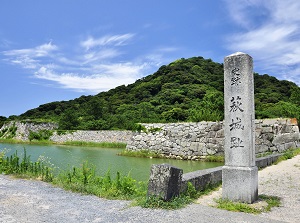
Ruin of Hagi Castle & Mt.Shizuki
Photo: Yamaguchi Prefectural Tourism Federation
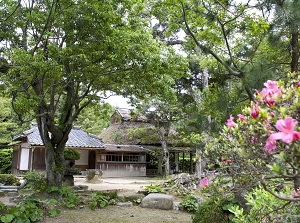
Shizuki Park in Hagi
Photo: Yamaguchi Prefectural Tourism Federation
The ruin of Hagi Castle is located at the northwest end of the central Hagi city.
The castle was built at the foot of Mount Shizuki on the cape facing the Sea of Japan in 1604, so another name is "Shizuki Castle".
The castle tower was demolished by Meiji government in 1874, then the stone walls and moats remain now.
The site around this castle has been improved as Shizuki Park (指月公園).
The old-growth forest on Mount Shizuki has been designated as a national natural treasure.
Old Castle Town
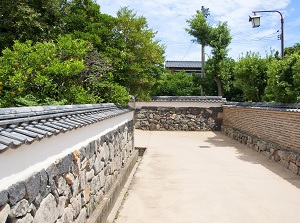
A street in Horiuchi
Photo: Yamaguchi Prefectural Tourism Federation
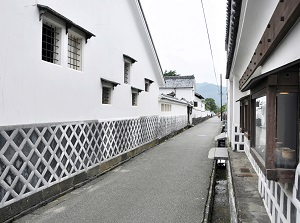
Kikuya-Yokocho in Hagi
Photo: Yamaguchi Prefectural Tourism Federation
Castle town of Hagi spreads to the southeast of the castle.
The district just to the southeast side of the castle is called Horiuchi (堀内).
The area is about 1 km from east to west and about 0.8 km from north to south.
Originally, many samurai residence to serve the castle lived in this district.
And several offices of Choshu Clan were set up.
Now, there are more than a dozen of former samurai residences, many earthen fences and stone walls.
The center of old town is to the east of Horiuchi.
It is about 1 km square and the streets are laid out in a grid.
Low-ranking samurais and common citizen lived in this district, and there are many Buddhist temples and old houses in this area.
Especially, three alleys about 250 meters long running from north to south retain the look of old times.
They are Kikuya-Yokocho (菊屋横町), Iseya-Yokocho (伊勢屋横町) and Edoya-Yokocho (江戸屋横町).
By the alleys, there are the houses of Takasugi Shinsaku (1839-1867) and Kido Takayoshi (1833-1877) who were the activist and politician to overthrow the Edo Government.
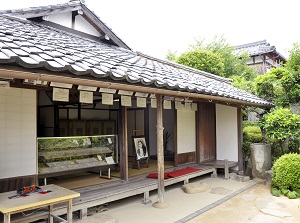
House of Takasugi Shinsaku
Photo: Yamaguchi Prefectural Tourism Federation
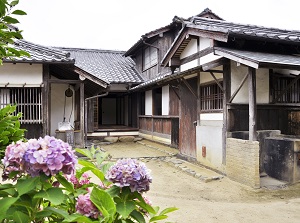
House of Kido Takayoshi in Hagi
Photo: Yamaguchi Prefectural Tourism Federation
There is Hamasaki (浜崎) district to the north of the castle town, and faces the Sea of Japan.
There is a harbor, and more than 130 old houses are in this district.
Hiyako district (平安古) is to the south of Horiuchi district.
Many samurai residences with long earthen fences remain.
Daisho-in temple (大照院)
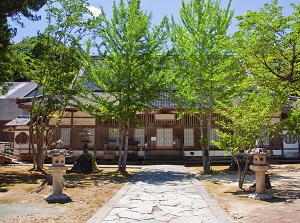
Daisho-in in Hagi
Photo: Yamaguchi Prefectural Tourism Federation
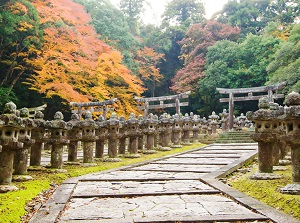
Stone lanterns in Daisho-in
Photo: Yamaguchi Prefectural Tourism Federation
Daisho-in is a Buddhist temple of Rinzai Zen school.
It is located to the south of central Hagi city, and is about 0.9 km west of Hagi station.
It is said that a temple was founded in the end of the 8th century.
Around 1654, this temple was reconstructed to be the temple for Môri family, the lord of Hagi Clan.
The lords of Môri family with even-numbered generation has been buried in this temple.
There are a few tens of tombs of Môri family and about 600 stone lanterns.
Shôkasonjuku school (松下村塾)
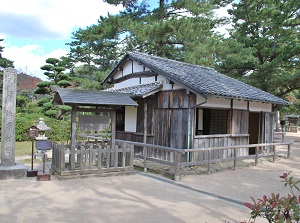
Shokasinjuku in Hagi
Photo: Yamaguchi Prefectural Tourism Federation
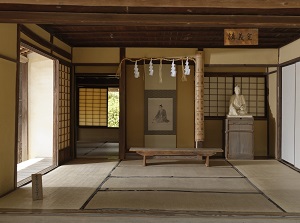
Inside of Shokasinjuku
Photo: Yamaguchi Prefectural Tourism Federation
Shôkasonjuku is the school managed by Yoshida Shoin, and is in the precinct of Shoin Shrine located about 1 km southeast of JR Higashi-Hagi station.
The original school was founded by Shoin's uncle in 1842 and Shoin was also one of the students.
Shoin taught as the leader from 1857.
He received not only samurai but also townspeople, and educated various subjects including the new Western learning.
And he created many excellent students, then they constructed the new Japan.
But Shoin was put to death as one of dangerous persons to overthrow the government in 1858, then this school was closed.
After the Meiji Restoration in 1868, the school was restarted, and was continued until 1892.
The current small schoolhouse is the building restored at that time.
Ito Hirobumi's house (伊藤博文旧宅)
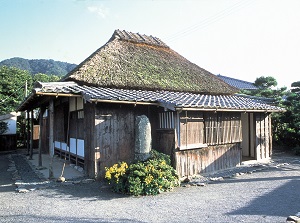
Ito Hirobumi's house
Photo: Yamaguchi Prefectural Tourism Federation
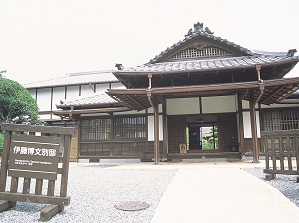
Moved buildings of Ito's residence
Photo: Yamaguchi Prefectural Tourism Federation
Ito Hirobumi (1841-1909) was born into a poor farm family.
He studied at Shôkasonjuku, and joined the movement to overthrow Edo Government.
Then, he became the Japan's first prime minister in 1890.
The house is located about 300 meters south of Shôkasonjuku, and he lived in the house in his youth from 1854 to 1868.
Near this house, there are main entrance and the halls in his residence which he built in Tokyo in 1907.
These were moved in 1998.
Tôkôji temple (東光寺)
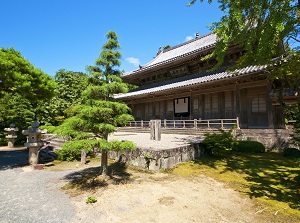
Tokoji in Hagi
Photo: Yamaguchi Prefectural Tourism Federation
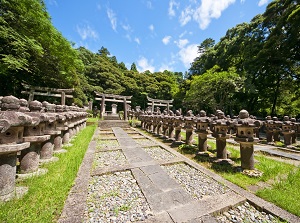
Stone lanterns in Tokoji
Photo: Yamaguchi Prefectural Tourism Federation
Tôkôji is a Buddhist temple located about 1 km east of Shôkasonjuku.
It was founded in 1691 by Môri Yoshinari (1668-1694) in 1691, the 3rd lord of this clan.
The temples have the essences of Chinese architecture.
The lords of Môri family with odd-numbered generation has been buried in this temple.
There are a few tens of tombs of Môri family and about 500 stone lanterns.
Kasayama volcano (笠山)
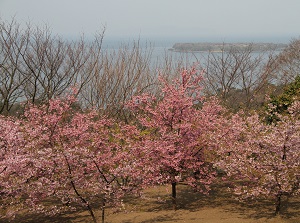
Observatory on Kasayama
Photo: Yamaguchi Prefectural Tourism Federation
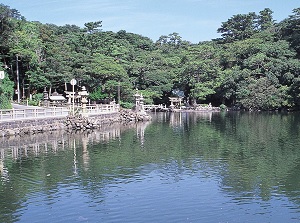
Myojin-ike pond
Photo: Yamaguchi Prefectural Tourism Federation
Kasayama is the world's smallest volcano, and is about 5 km north of central Hagi city.
It is only 112 meters high, and has a crater about 30 meters in diameter.
The last eruption was about 10,000 years ago.
We can walk on the edge of the crater, and the place is a nice observatory.
There is Myôjin-ike pond (明神池) at the east foot of Kasayama.
Despite a pond on the land, it has marine water and many fish in the sea swims.
Because, this pond was formed by connecting Kasayama in the sea and the land with deposition of sands and stones.
How to get here
By express bus, about 1.5 hours from Shin-Yamaguchi station (Shinkansen), about 1 hour and 20 minutes from JR Yamaguchi station.
Or, from Hagi-Iwami Airport, by route bus, about 1 hour and 10 minutes to Hagi city.
(Hagi-Iwami Airport has a few flights from Haneda (Tokyo) in a day.)
Higashi-Hagi is a station of JR San-in Line, but no limited express is operated on the section around here.
So if you use JR train, it takes much times. (More than 4 hours from Yamaguchi)

